Microeconomics Assignment 2: Analysis of the US Airline Industry
VerifiedAdded on 2023/05/27
|8
|2059
|489
Report
AI Summary
This report provides a comprehensive analysis of the US airline industry, focusing on its market structure, competition, and externalities. The study begins with an overview of the industry, highlighting its significance in the global civil aviation sector and its substantial contribution to the US economy. The report then delves into the market structure, characterizing it as a monopolistic competition due to the presence of numerous private airline companies, each offering differentiated services. The report discusses the market shares of major players such as American Airlines, South West Airlines, Delta Airlines, and United Airlines. The report also examines the externalities associated with the industry, both positive, such as facilitating global connectivity, and negative, such as noise and air pollution. The study concludes by summarizing the key findings, emphasizing the industry's competitive dynamics and its impact on the national economy. The report uses secondary research, referencing sources like the Federal Reserve and various airline companies, and fulfills the requirements of a microeconomics assignment.
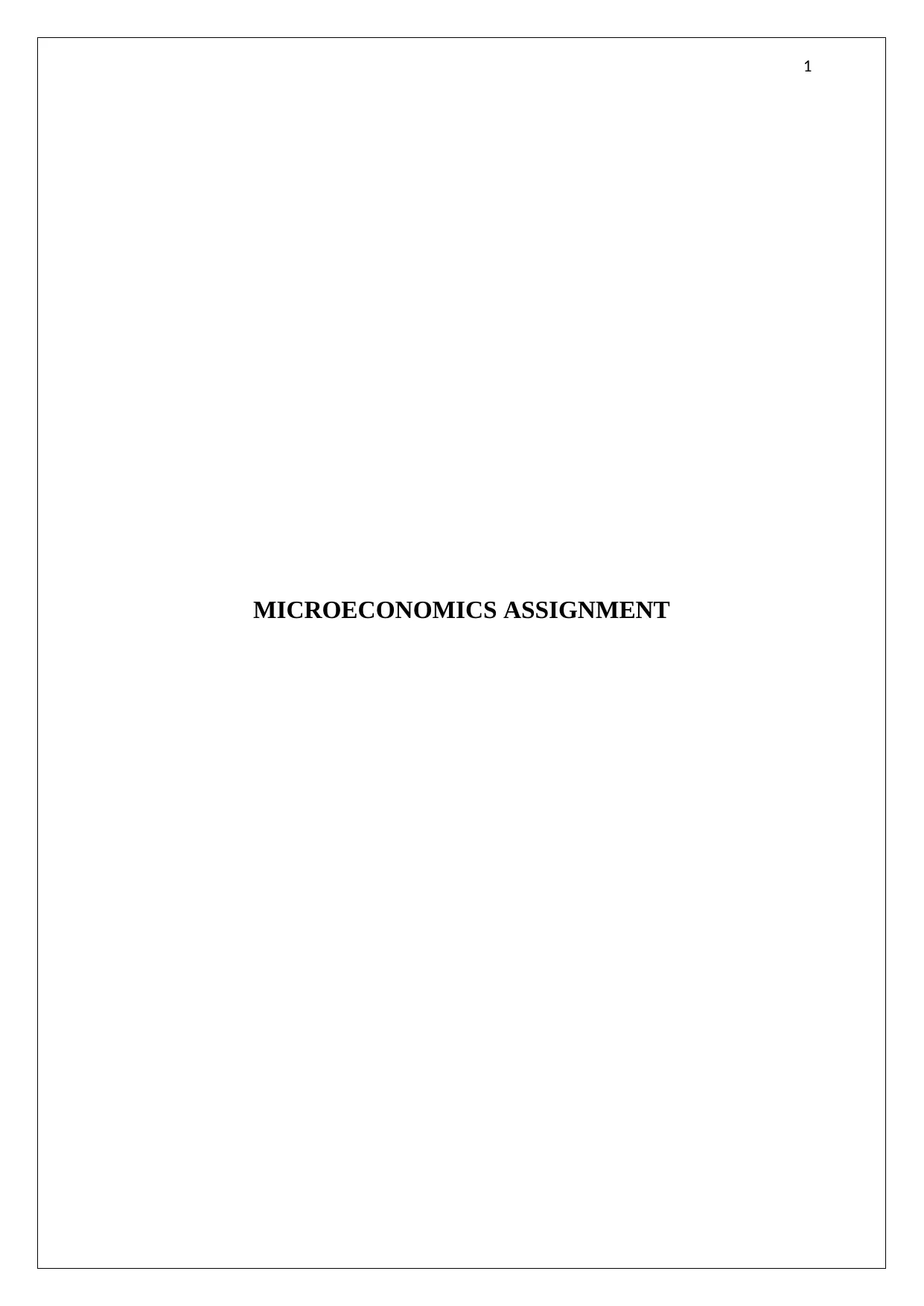
1
MICROECONOMICS ASSIGNMENT
MICROECONOMICS ASSIGNMENT
Paraphrase This Document
Need a fresh take? Get an instant paraphrase of this document with our AI Paraphraser
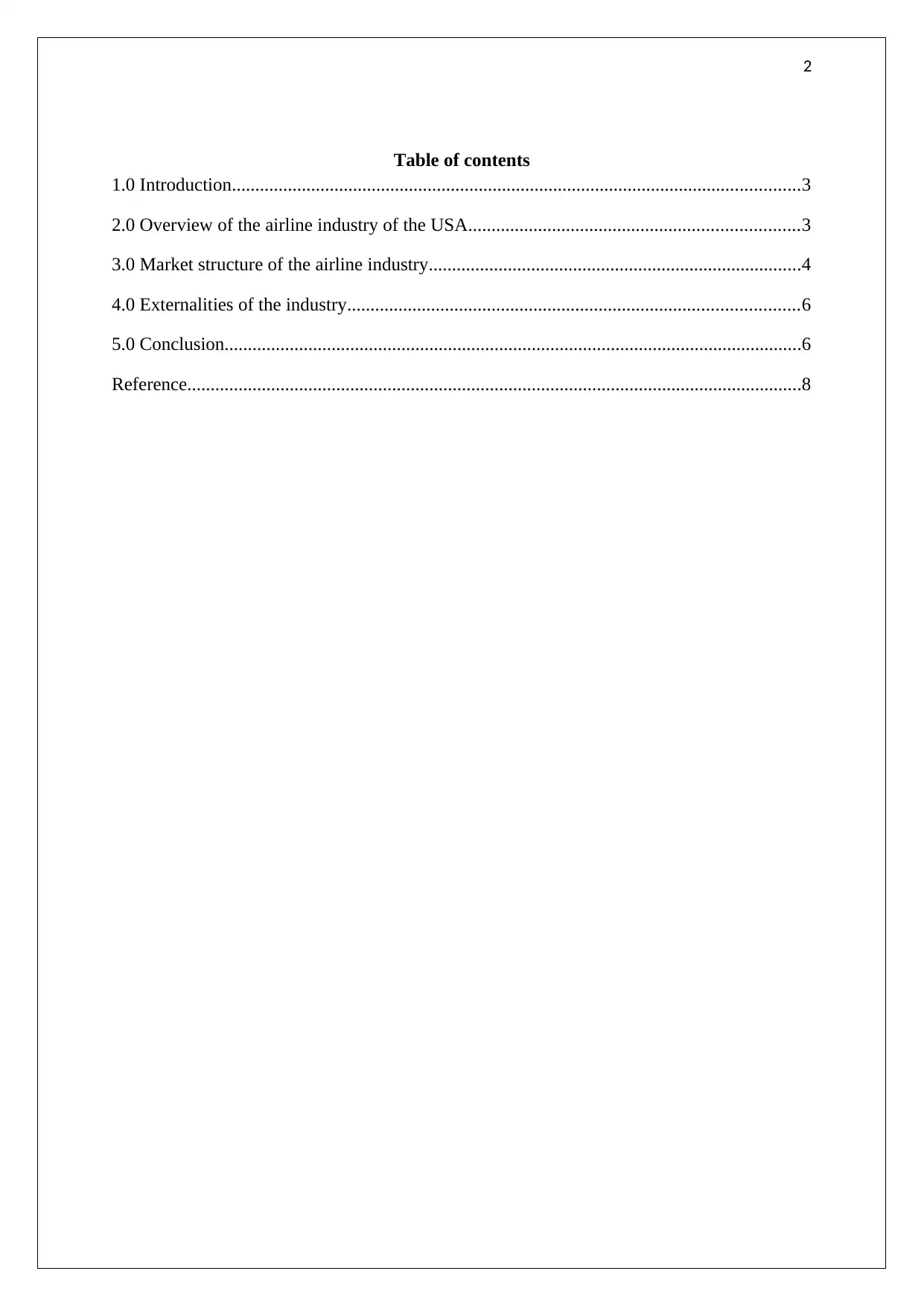
2
Table of contents
1.0 Introduction..........................................................................................................................3
2.0 Overview of the airline industry of the USA.......................................................................3
3.0 Market structure of the airline industry................................................................................4
4.0 Externalities of the industry.................................................................................................6
5.0 Conclusion............................................................................................................................6
Reference....................................................................................................................................8
Table of contents
1.0 Introduction..........................................................................................................................3
2.0 Overview of the airline industry of the USA.......................................................................3
3.0 Market structure of the airline industry................................................................................4
4.0 Externalities of the industry.................................................................................................6
5.0 Conclusion............................................................................................................................6
Reference....................................................................................................................................8
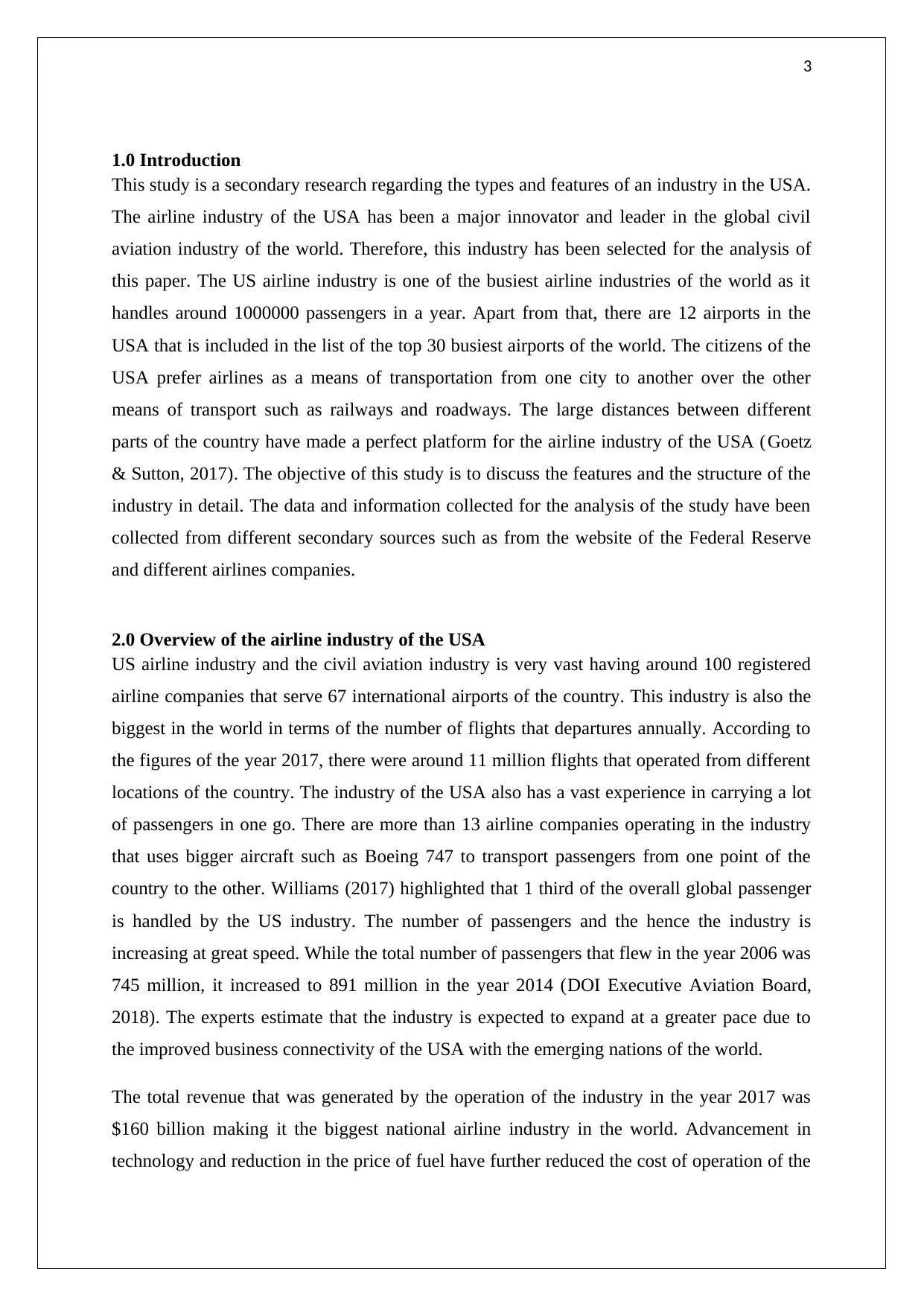
3
1.0 Introduction
This study is a secondary research regarding the types and features of an industry in the USA.
The airline industry of the USA has been a major innovator and leader in the global civil
aviation industry of the world. Therefore, this industry has been selected for the analysis of
this paper. The US airline industry is one of the busiest airline industries of the world as it
handles around 1000000 passengers in a year. Apart from that, there are 12 airports in the
USA that is included in the list of the top 30 busiest airports of the world. The citizens of the
USA prefer airlines as a means of transportation from one city to another over the other
means of transport such as railways and roadways. The large distances between different
parts of the country have made a perfect platform for the airline industry of the USA (Goetz
& Sutton, 2017). The objective of this study is to discuss the features and the structure of the
industry in detail. The data and information collected for the analysis of the study have been
collected from different secondary sources such as from the website of the Federal Reserve
and different airlines companies.
2.0 Overview of the airline industry of the USA
US airline industry and the civil aviation industry is very vast having around 100 registered
airline companies that serve 67 international airports of the country. This industry is also the
biggest in the world in terms of the number of flights that departures annually. According to
the figures of the year 2017, there were around 11 million flights that operated from different
locations of the country. The industry of the USA also has a vast experience in carrying a lot
of passengers in one go. There are more than 13 airline companies operating in the industry
that uses bigger aircraft such as Boeing 747 to transport passengers from one point of the
country to the other. Williams (2017) highlighted that 1 third of the overall global passenger
is handled by the US industry. The number of passengers and the hence the industry is
increasing at great speed. While the total number of passengers that flew in the year 2006 was
745 million, it increased to 891 million in the year 2014 (DOI Executive Aviation Board,
2018). The experts estimate that the industry is expected to expand at a greater pace due to
the improved business connectivity of the USA with the emerging nations of the world.
The total revenue that was generated by the operation of the industry in the year 2017 was
$160 billion making it the biggest national airline industry in the world. Advancement in
technology and reduction in the price of fuel have further reduced the cost of operation of the
1.0 Introduction
This study is a secondary research regarding the types and features of an industry in the USA.
The airline industry of the USA has been a major innovator and leader in the global civil
aviation industry of the world. Therefore, this industry has been selected for the analysis of
this paper. The US airline industry is one of the busiest airline industries of the world as it
handles around 1000000 passengers in a year. Apart from that, there are 12 airports in the
USA that is included in the list of the top 30 busiest airports of the world. The citizens of the
USA prefer airlines as a means of transportation from one city to another over the other
means of transport such as railways and roadways. The large distances between different
parts of the country have made a perfect platform for the airline industry of the USA (Goetz
& Sutton, 2017). The objective of this study is to discuss the features and the structure of the
industry in detail. The data and information collected for the analysis of the study have been
collected from different secondary sources such as from the website of the Federal Reserve
and different airlines companies.
2.0 Overview of the airline industry of the USA
US airline industry and the civil aviation industry is very vast having around 100 registered
airline companies that serve 67 international airports of the country. This industry is also the
biggest in the world in terms of the number of flights that departures annually. According to
the figures of the year 2017, there were around 11 million flights that operated from different
locations of the country. The industry of the USA also has a vast experience in carrying a lot
of passengers in one go. There are more than 13 airline companies operating in the industry
that uses bigger aircraft such as Boeing 747 to transport passengers from one point of the
country to the other. Williams (2017) highlighted that 1 third of the overall global passenger
is handled by the US industry. The number of passengers and the hence the industry is
increasing at great speed. While the total number of passengers that flew in the year 2006 was
745 million, it increased to 891 million in the year 2014 (DOI Executive Aviation Board,
2018). The experts estimate that the industry is expected to expand at a greater pace due to
the improved business connectivity of the USA with the emerging nations of the world.
The total revenue that was generated by the operation of the industry in the year 2017 was
$160 billion making it the biggest national airline industry in the world. Advancement in
technology and reduction in the price of fuel have further reduced the cost of operation of the
⊘ This is a preview!⊘
Do you want full access?
Subscribe today to unlock all pages.

Trusted by 1+ million students worldwide
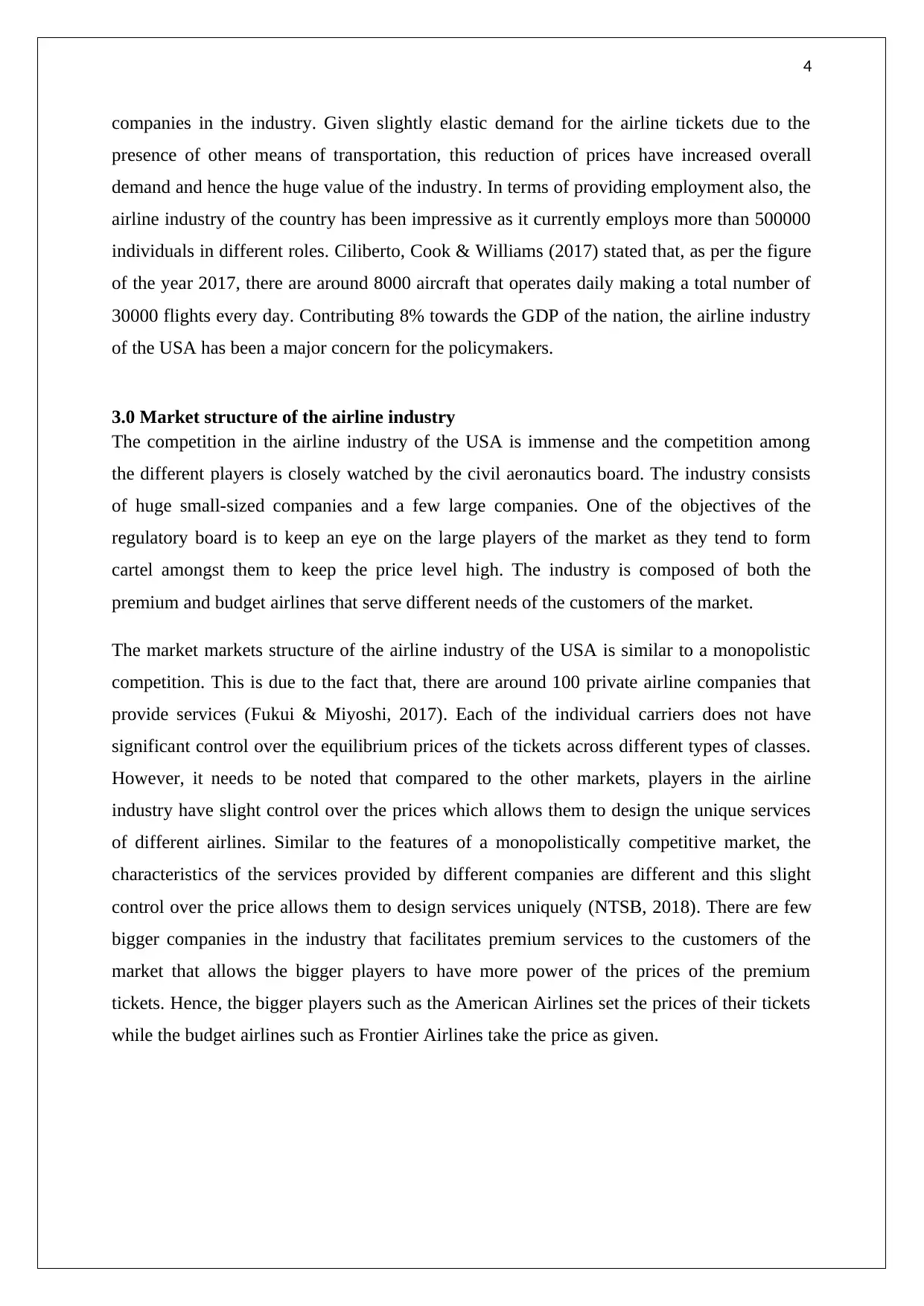
4
companies in the industry. Given slightly elastic demand for the airline tickets due to the
presence of other means of transportation, this reduction of prices have increased overall
demand and hence the huge value of the industry. In terms of providing employment also, the
airline industry of the country has been impressive as it currently employs more than 500000
individuals in different roles. Ciliberto, Cook & Williams (2017) stated that, as per the figure
of the year 2017, there are around 8000 aircraft that operates daily making a total number of
30000 flights every day. Contributing 8% towards the GDP of the nation, the airline industry
of the USA has been a major concern for the policymakers.
3.0 Market structure of the airline industry
The competition in the airline industry of the USA is immense and the competition among
the different players is closely watched by the civil aeronautics board. The industry consists
of huge small-sized companies and a few large companies. One of the objectives of the
regulatory board is to keep an eye on the large players of the market as they tend to form
cartel amongst them to keep the price level high. The industry is composed of both the
premium and budget airlines that serve different needs of the customers of the market.
The market markets structure of the airline industry of the USA is similar to a monopolistic
competition. This is due to the fact that, there are around 100 private airline companies that
provide services (Fukui & Miyoshi, 2017). Each of the individual carriers does not have
significant control over the equilibrium prices of the tickets across different types of classes.
However, it needs to be noted that compared to the other markets, players in the airline
industry have slight control over the prices which allows them to design the unique services
of different airlines. Similar to the features of a monopolistically competitive market, the
characteristics of the services provided by different companies are different and this slight
control over the price allows them to design services uniquely (NTSB, 2018). There are few
bigger companies in the industry that facilitates premium services to the customers of the
market that allows the bigger players to have more power of the prices of the premium
tickets. Hence, the bigger players such as the American Airlines set the prices of their tickets
while the budget airlines such as Frontier Airlines take the price as given.
companies in the industry. Given slightly elastic demand for the airline tickets due to the
presence of other means of transportation, this reduction of prices have increased overall
demand and hence the huge value of the industry. In terms of providing employment also, the
airline industry of the country has been impressive as it currently employs more than 500000
individuals in different roles. Ciliberto, Cook & Williams (2017) stated that, as per the figure
of the year 2017, there are around 8000 aircraft that operates daily making a total number of
30000 flights every day. Contributing 8% towards the GDP of the nation, the airline industry
of the USA has been a major concern for the policymakers.
3.0 Market structure of the airline industry
The competition in the airline industry of the USA is immense and the competition among
the different players is closely watched by the civil aeronautics board. The industry consists
of huge small-sized companies and a few large companies. One of the objectives of the
regulatory board is to keep an eye on the large players of the market as they tend to form
cartel amongst them to keep the price level high. The industry is composed of both the
premium and budget airlines that serve different needs of the customers of the market.
The market markets structure of the airline industry of the USA is similar to a monopolistic
competition. This is due to the fact that, there are around 100 private airline companies that
provide services (Fukui & Miyoshi, 2017). Each of the individual carriers does not have
significant control over the equilibrium prices of the tickets across different types of classes.
However, it needs to be noted that compared to the other markets, players in the airline
industry have slight control over the prices which allows them to design the unique services
of different airlines. Similar to the features of a monopolistically competitive market, the
characteristics of the services provided by different companies are different and this slight
control over the price allows them to design services uniquely (NTSB, 2018). There are few
bigger companies in the industry that facilitates premium services to the customers of the
market that allows the bigger players to have more power of the prices of the premium
tickets. Hence, the bigger players such as the American Airlines set the prices of their tickets
while the budget airlines such as Frontier Airlines take the price as given.
Paraphrase This Document
Need a fresh take? Get an instant paraphrase of this document with our AI Paraphraser
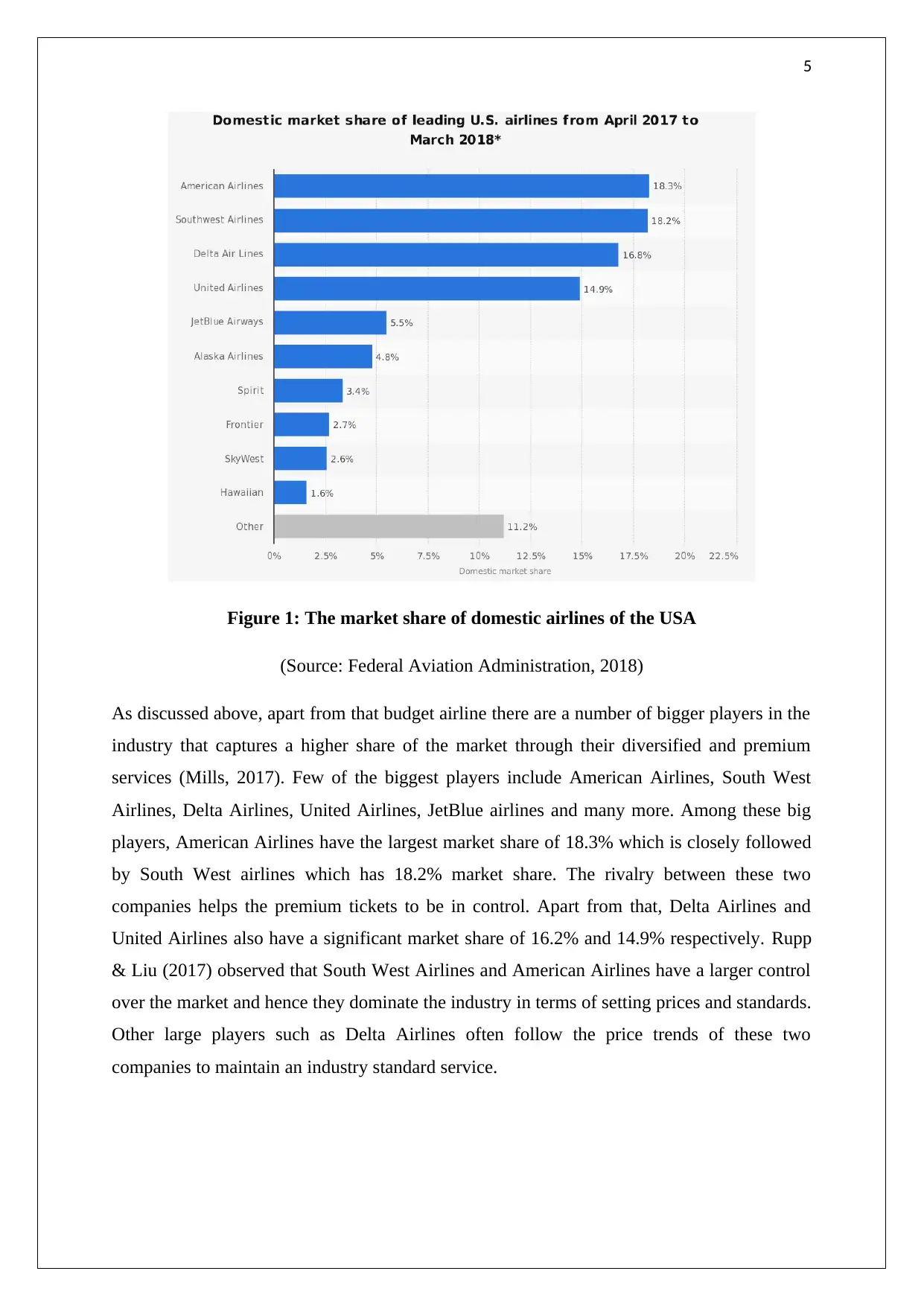
5
Figure 1: The market share of domestic airlines of the USA
(Source: Federal Aviation Administration, 2018)
As discussed above, apart from that budget airline there are a number of bigger players in the
industry that captures a higher share of the market through their diversified and premium
services (Mills, 2017). Few of the biggest players include American Airlines, South West
Airlines, Delta Airlines, United Airlines, JetBlue airlines and many more. Among these big
players, American Airlines have the largest market share of 18.3% which is closely followed
by South West airlines which has 18.2% market share. The rivalry between these two
companies helps the premium tickets to be in control. Apart from that, Delta Airlines and
United Airlines also have a significant market share of 16.2% and 14.9% respectively. Rupp
& Liu (2017) observed that South West Airlines and American Airlines have a larger control
over the market and hence they dominate the industry in terms of setting prices and standards.
Other large players such as Delta Airlines often follow the price trends of these two
companies to maintain an industry standard service.
Figure 1: The market share of domestic airlines of the USA
(Source: Federal Aviation Administration, 2018)
As discussed above, apart from that budget airline there are a number of bigger players in the
industry that captures a higher share of the market through their diversified and premium
services (Mills, 2017). Few of the biggest players include American Airlines, South West
Airlines, Delta Airlines, United Airlines, JetBlue airlines and many more. Among these big
players, American Airlines have the largest market share of 18.3% which is closely followed
by South West airlines which has 18.2% market share. The rivalry between these two
companies helps the premium tickets to be in control. Apart from that, Delta Airlines and
United Airlines also have a significant market share of 16.2% and 14.9% respectively. Rupp
& Liu (2017) observed that South West Airlines and American Airlines have a larger control
over the market and hence they dominate the industry in terms of setting prices and standards.
Other large players such as Delta Airlines often follow the price trends of these two
companies to maintain an industry standard service.
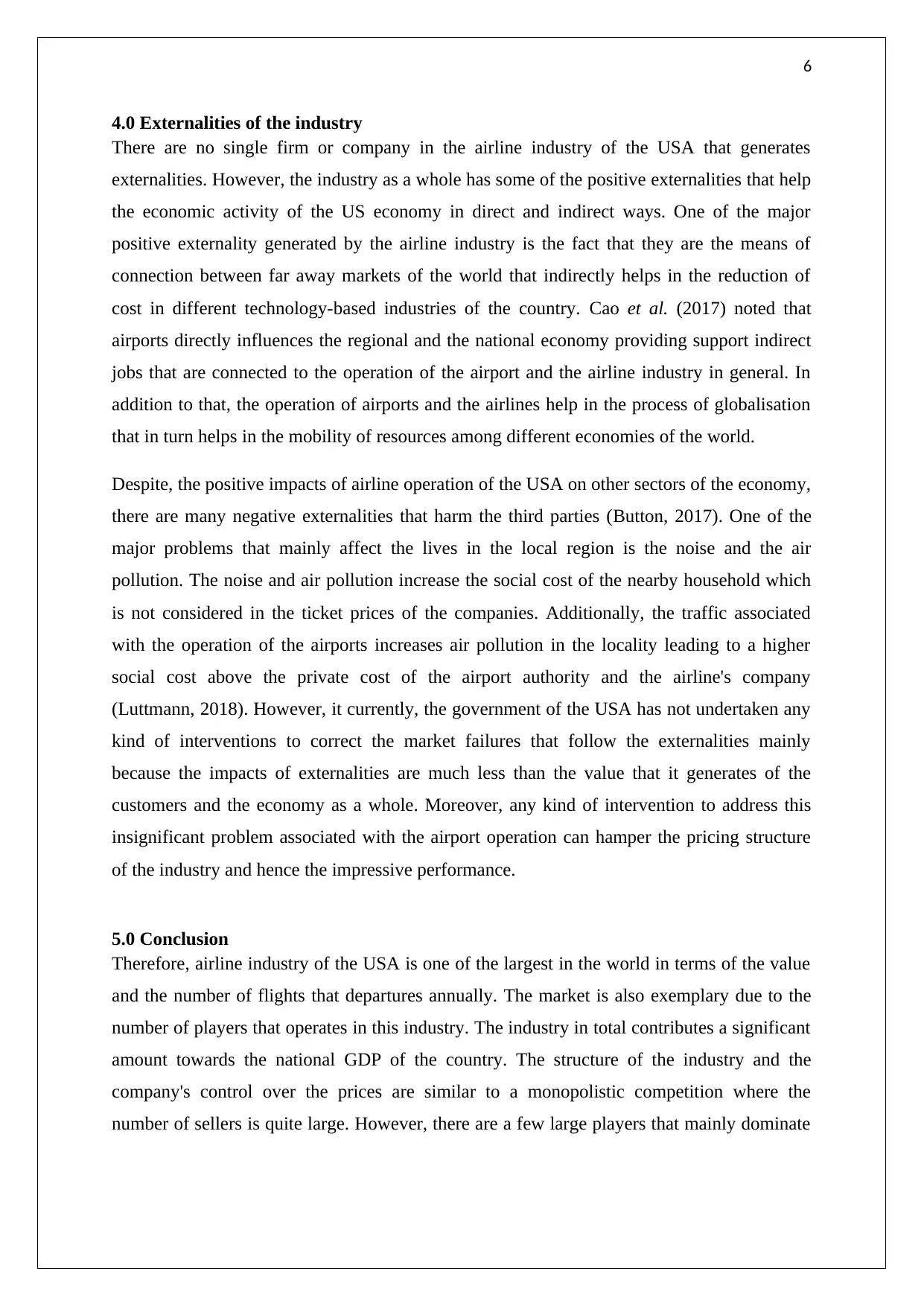
6
4.0 Externalities of the industry
There are no single firm or company in the airline industry of the USA that generates
externalities. However, the industry as a whole has some of the positive externalities that help
the economic activity of the US economy in direct and indirect ways. One of the major
positive externality generated by the airline industry is the fact that they are the means of
connection between far away markets of the world that indirectly helps in the reduction of
cost in different technology-based industries of the country. Cao et al. (2017) noted that
airports directly influences the regional and the national economy providing support indirect
jobs that are connected to the operation of the airport and the airline industry in general. In
addition to that, the operation of airports and the airlines help in the process of globalisation
that in turn helps in the mobility of resources among different economies of the world.
Despite, the positive impacts of airline operation of the USA on other sectors of the economy,
there are many negative externalities that harm the third parties (Button, 2017). One of the
major problems that mainly affect the lives in the local region is the noise and the air
pollution. The noise and air pollution increase the social cost of the nearby household which
is not considered in the ticket prices of the companies. Additionally, the traffic associated
with the operation of the airports increases air pollution in the locality leading to a higher
social cost above the private cost of the airport authority and the airline's company
(Luttmann, 2018). However, it currently, the government of the USA has not undertaken any
kind of interventions to correct the market failures that follow the externalities mainly
because the impacts of externalities are much less than the value that it generates of the
customers and the economy as a whole. Moreover, any kind of intervention to address this
insignificant problem associated with the airport operation can hamper the pricing structure
of the industry and hence the impressive performance.
5.0 Conclusion
Therefore, airline industry of the USA is one of the largest in the world in terms of the value
and the number of flights that departures annually. The market is also exemplary due to the
number of players that operates in this industry. The industry in total contributes a significant
amount towards the national GDP of the country. The structure of the industry and the
company's control over the prices are similar to a monopolistic competition where the
number of sellers is quite large. However, there are a few large players that mainly dominate
4.0 Externalities of the industry
There are no single firm or company in the airline industry of the USA that generates
externalities. However, the industry as a whole has some of the positive externalities that help
the economic activity of the US economy in direct and indirect ways. One of the major
positive externality generated by the airline industry is the fact that they are the means of
connection between far away markets of the world that indirectly helps in the reduction of
cost in different technology-based industries of the country. Cao et al. (2017) noted that
airports directly influences the regional and the national economy providing support indirect
jobs that are connected to the operation of the airport and the airline industry in general. In
addition to that, the operation of airports and the airlines help in the process of globalisation
that in turn helps in the mobility of resources among different economies of the world.
Despite, the positive impacts of airline operation of the USA on other sectors of the economy,
there are many negative externalities that harm the third parties (Button, 2017). One of the
major problems that mainly affect the lives in the local region is the noise and the air
pollution. The noise and air pollution increase the social cost of the nearby household which
is not considered in the ticket prices of the companies. Additionally, the traffic associated
with the operation of the airports increases air pollution in the locality leading to a higher
social cost above the private cost of the airport authority and the airline's company
(Luttmann, 2018). However, it currently, the government of the USA has not undertaken any
kind of interventions to correct the market failures that follow the externalities mainly
because the impacts of externalities are much less than the value that it generates of the
customers and the economy as a whole. Moreover, any kind of intervention to address this
insignificant problem associated with the airport operation can hamper the pricing structure
of the industry and hence the impressive performance.
5.0 Conclusion
Therefore, airline industry of the USA is one of the largest in the world in terms of the value
and the number of flights that departures annually. The market is also exemplary due to the
number of players that operates in this industry. The industry in total contributes a significant
amount towards the national GDP of the country. The structure of the industry and the
company's control over the prices are similar to a monopolistic competition where the
number of sellers is quite large. However, there are a few large players that mainly dominate
⊘ This is a preview!⊘
Do you want full access?
Subscribe today to unlock all pages.

Trusted by 1+ million students worldwide
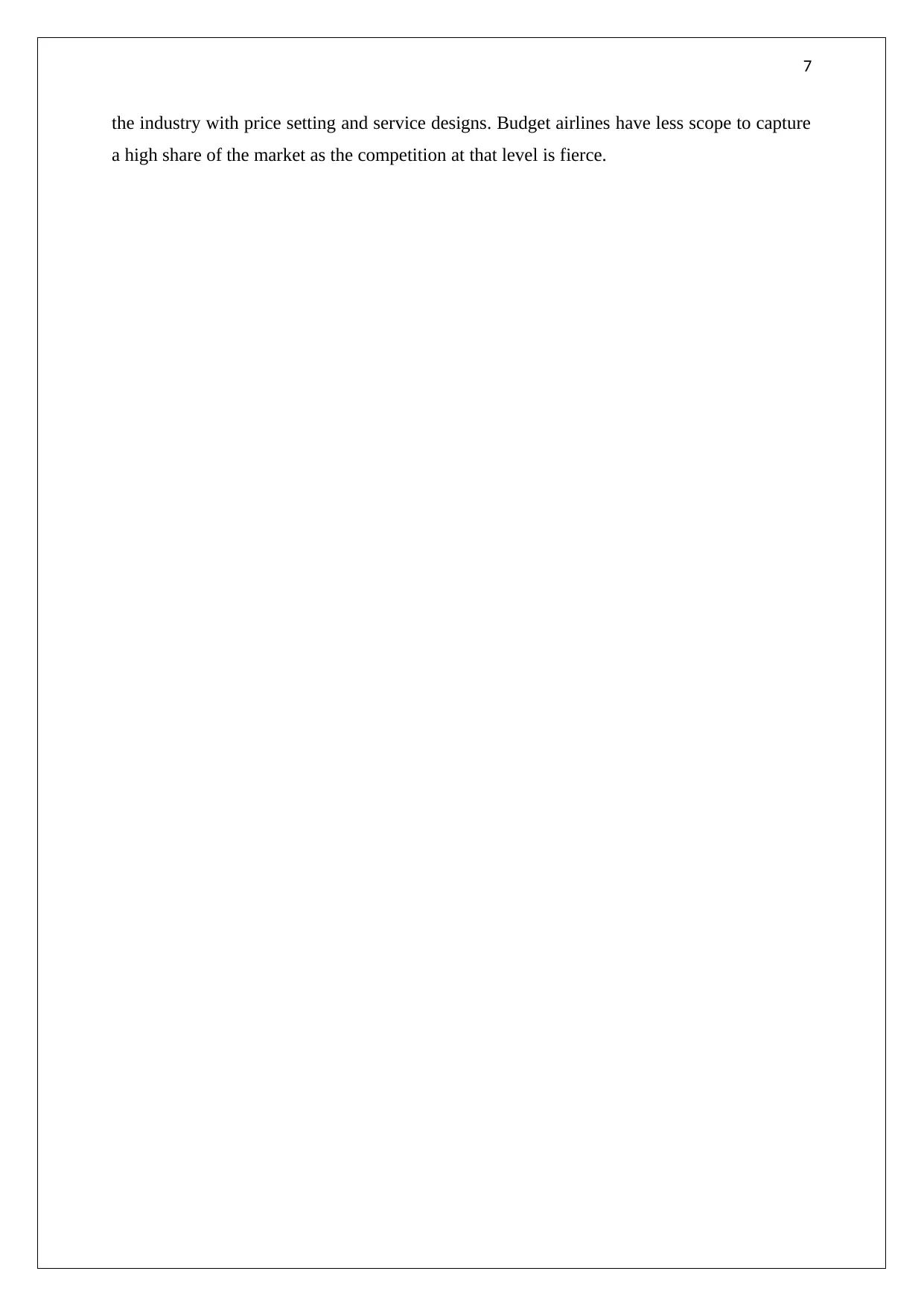
7
the industry with price setting and service designs. Budget airlines have less scope to capture
a high share of the market as the competition at that level is fierce.
the industry with price setting and service designs. Budget airlines have less scope to capture
a high share of the market as the competition at that level is fierce.
Paraphrase This Document
Need a fresh take? Get an instant paraphrase of this document with our AI Paraphraser
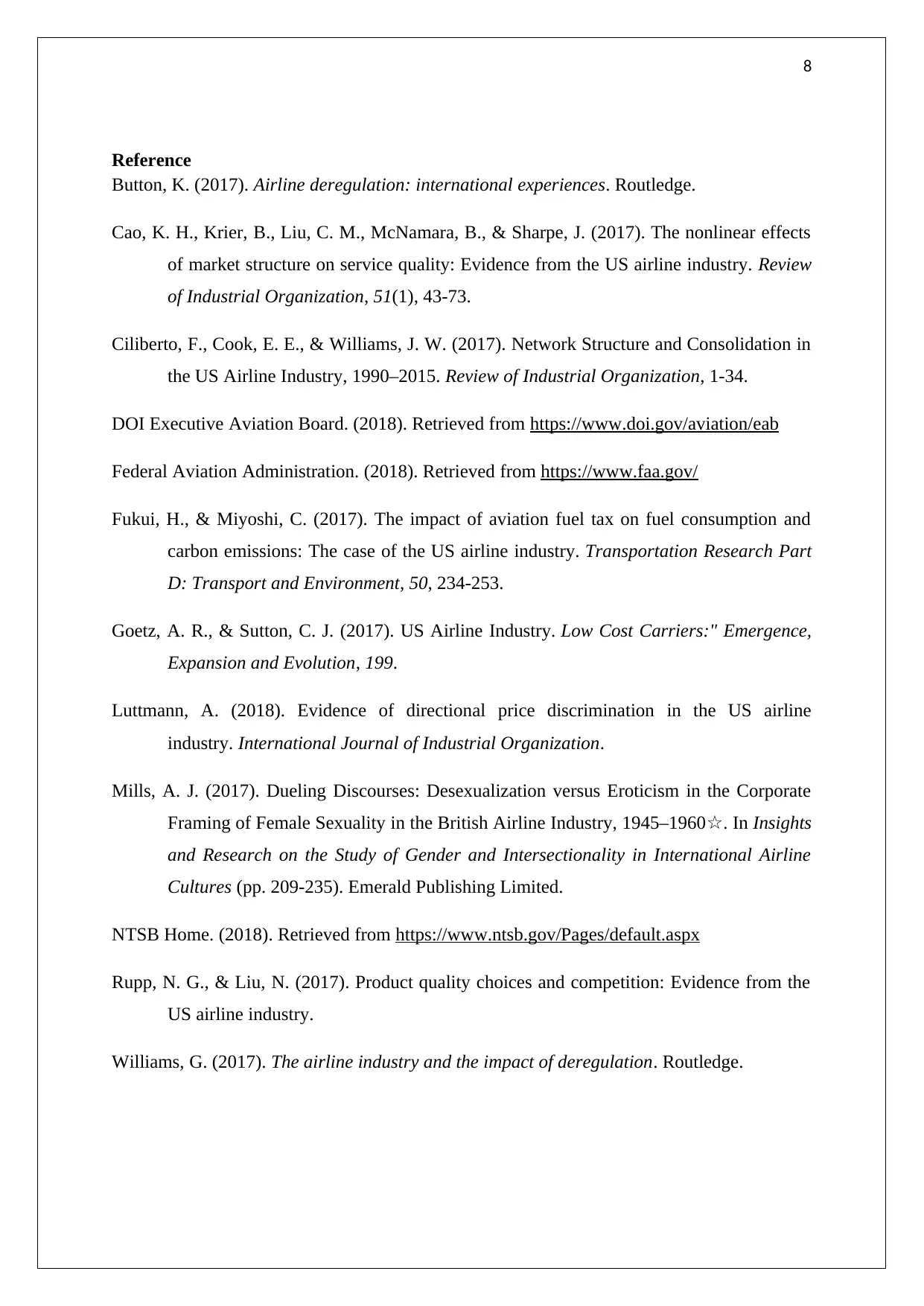
8
Reference
Button, K. (2017). Airline deregulation: international experiences. Routledge.
Cao, K. H., Krier, B., Liu, C. M., McNamara, B., & Sharpe, J. (2017). The nonlinear effects
of market structure on service quality: Evidence from the US airline industry. Review
of Industrial Organization, 51(1), 43-73.
Ciliberto, F., Cook, E. E., & Williams, J. W. (2017). Network Structure and Consolidation in
the US Airline Industry, 1990–2015. Review of Industrial Organization, 1-34.
DOI Executive Aviation Board. (2018). Retrieved from https://www.doi.gov/aviation/eab
Federal Aviation Administration. (2018). Retrieved from https://www.faa.gov/
Fukui, H., & Miyoshi, C. (2017). The impact of aviation fuel tax on fuel consumption and
carbon emissions: The case of the US airline industry. Transportation Research Part
D: Transport and Environment, 50, 234-253.
Goetz, A. R., & Sutton, C. J. (2017). US Airline Industry. Low Cost Carriers:" Emergence,
Expansion and Evolution, 199.
Luttmann, A. (2018). Evidence of directional price discrimination in the US airline
industry. International Journal of Industrial Organization.
Mills, A. J. (2017). Dueling Discourses: Desexualization versus Eroticism in the Corporate
Framing of Female Sexuality in the British Airline Industry, 1945–1960☆. In Insights
and Research on the Study of Gender and Intersectionality in International Airline
Cultures (pp. 209-235). Emerald Publishing Limited.
NTSB Home. (2018). Retrieved from https://www.ntsb.gov/Pages/default.aspx
Rupp, N. G., & Liu, N. (2017). Product quality choices and competition: Evidence from the
US airline industry.
Williams, G. (2017). The airline industry and the impact of deregulation. Routledge.
Reference
Button, K. (2017). Airline deregulation: international experiences. Routledge.
Cao, K. H., Krier, B., Liu, C. M., McNamara, B., & Sharpe, J. (2017). The nonlinear effects
of market structure on service quality: Evidence from the US airline industry. Review
of Industrial Organization, 51(1), 43-73.
Ciliberto, F., Cook, E. E., & Williams, J. W. (2017). Network Structure and Consolidation in
the US Airline Industry, 1990–2015. Review of Industrial Organization, 1-34.
DOI Executive Aviation Board. (2018). Retrieved from https://www.doi.gov/aviation/eab
Federal Aviation Administration. (2018). Retrieved from https://www.faa.gov/
Fukui, H., & Miyoshi, C. (2017). The impact of aviation fuel tax on fuel consumption and
carbon emissions: The case of the US airline industry. Transportation Research Part
D: Transport and Environment, 50, 234-253.
Goetz, A. R., & Sutton, C. J. (2017). US Airline Industry. Low Cost Carriers:" Emergence,
Expansion and Evolution, 199.
Luttmann, A. (2018). Evidence of directional price discrimination in the US airline
industry. International Journal of Industrial Organization.
Mills, A. J. (2017). Dueling Discourses: Desexualization versus Eroticism in the Corporate
Framing of Female Sexuality in the British Airline Industry, 1945–1960☆. In Insights
and Research on the Study of Gender and Intersectionality in International Airline
Cultures (pp. 209-235). Emerald Publishing Limited.
NTSB Home. (2018). Retrieved from https://www.ntsb.gov/Pages/default.aspx
Rupp, N. G., & Liu, N. (2017). Product quality choices and competition: Evidence from the
US airline industry.
Williams, G. (2017). The airline industry and the impact of deregulation. Routledge.
1 out of 8
Related Documents
Your All-in-One AI-Powered Toolkit for Academic Success.
+13062052269
info@desklib.com
Available 24*7 on WhatsApp / Email
![[object Object]](/_next/static/media/star-bottom.7253800d.svg)
Unlock your academic potential
Copyright © 2020–2025 A2Z Services. All Rights Reserved. Developed and managed by ZUCOL.





